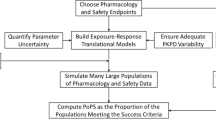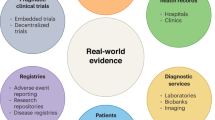Abstract
There is a broad need within the drug development industry for a new approach to understanding the ‘levels-of-proof’ that operate within a drug development programme. This article outlines a proposed system to address this need. We suggest a hierarchy, which could be used as a general communication tool and riskassessment device when managing stages of clinical development and discussing the proofs, and possible profits, of ‘effect’. This structure starts with low levels of proof such as basic pharmacokinetics being proof of systemic exposure; higher levels of proof then include proof of compartmental exposure where appropriate. The hierarchy then graduates on to proof of pharmacological activity ascending from simple receptor activities through to more downstream pathway-related effects. The final tiers in the hierarchy represent proof of activity in diseaserelated pathways, disease-related surrogates, registrable endpoints and finally the highest level of proof is in health economic-related outcomes such as quality-adjusted life-years.
The proposed ‘structure’ is intended to improve the confused terms of ‘proof of concept’ and ‘proof of principle’ and more adequately address the outmoded terms that relate to ‘phased drug development’. We do not envisage that these terms will be replaced but note that this new structure has the advantage of being based on scientific and medical rationale. Furthermore, we use this tool to aid thinking about risk/portfolio management.

Similar content being viewed by others
References
Choi DW. Exploratory clinical testing of neuroscience drugs. Nat Neurosci 2002; 5 Suppl.: 1023–5
DiMasi JA. The value of improving the productivity of the drug development process: faster times and better decisions. Pharmacoeconomics 2002; 20 Suppl. 3: 1–10
Kuhlmann J. Alternative strategies in drug development: clinical pharmacological aspects. Int J Clin Pharmacol Ther 1999; 37: 575–83
From test tube to patient: new drug development in the United States. 2nd ed. Besthesda (MD): Department of Health and Human Services, 1995 [online]. Available from URL: http://www.fda.gov/fdac/special/newdrug/ndd_toc.html [Accessed 2005 Sep 30]
Centre for Medicines Research [online]. Available from URL: http://www.cmr.org [Accessed 2005 Sep 30]
Gordon SM, Brahim JS, Rowan J, et al. Peripheral prostanoid levels and nonsteroidal anti-inflammatory drug analgesia: replicate clinical trials in a tissue injury model. Clin Pharmacol Ther 2002; 72: 175–83
Cohen MH, Williams GA, Sridhara R, et al. United States food and drug administration drug approval summary: Gefitinib (ZD1839; Iressa) tablets. Clin Cancer Res 2004; 10: 1212–8
Gleckman R. What do the new antimicrobials offer? Weighing the advantages and disadvantages compared with traditional agents. Postgrad Med 2001; 109: 87–91
Acknowledgements
Both authors are full-time and sole employees of AstraZeneca PLC. AstraZeneca PLC supports this document submission and the division of Experimental Medicine within AstraZeneca PLC acknowledges and condones the broad intent of the article. The company has given permission to publish both internally and externally through the usual company procedures.
Author information
Authors and Affiliations
Rights and permissions
About this article
Cite this article
Smethurst, D., Hughes, A. Staged Risk Management of Candidate Drug Efficacy. Int J Pharm Med 19, 227–232 (2005). https://doi.org/10.2165/00124363-200519040-00004
Published:
Issue Date:
DOI: https://doi.org/10.2165/00124363-200519040-00004




